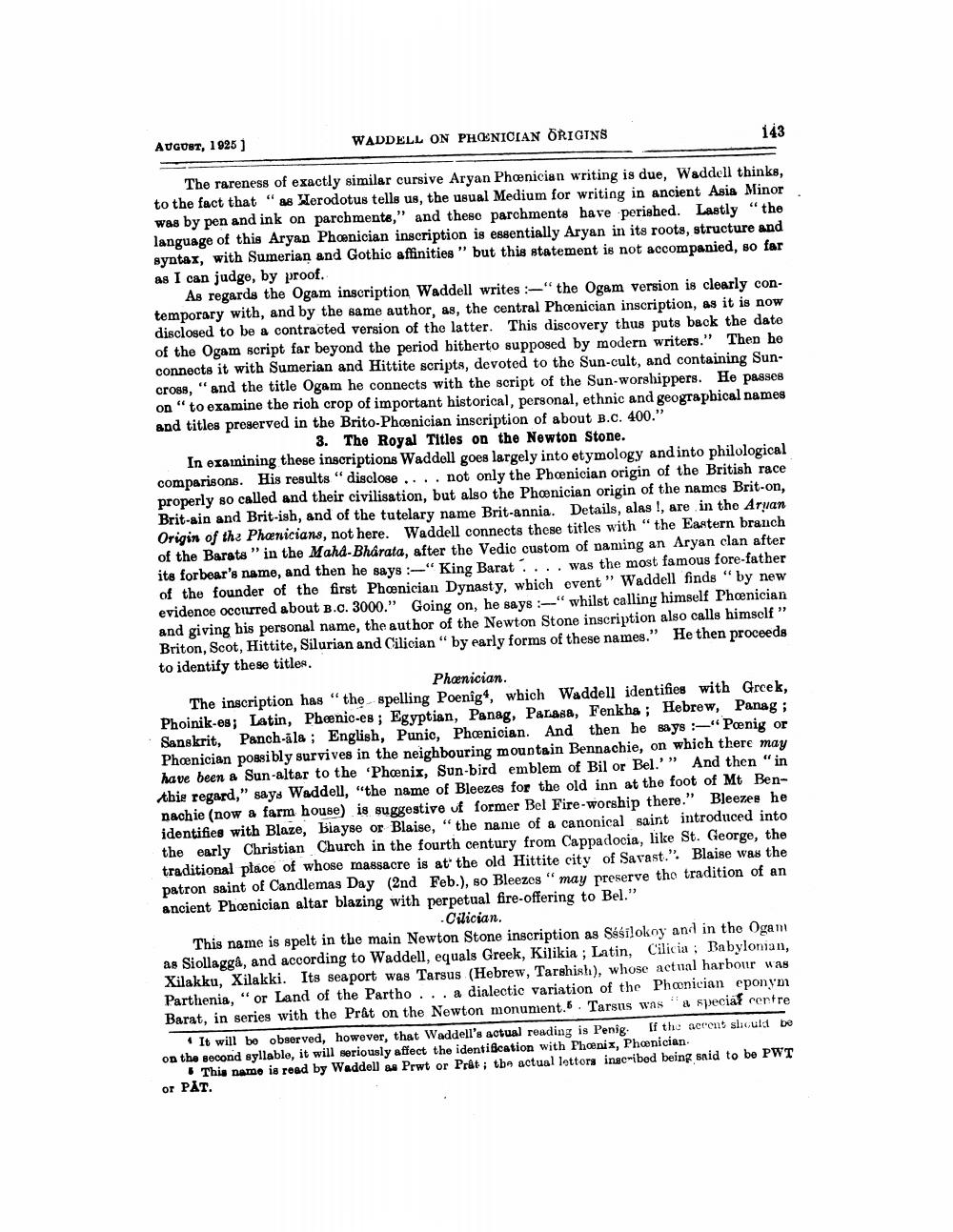________________
AUGUBT, 1925)
WADDELL ON PHÔNICIAN ORIGINS
143
The rareness of exactly similar cursive Aryan Phoenician writing is due, Waddell thinks, to the fact that "as Herodotus tells us, the usual Medium for writing in ancient Asia Minor was by pen and ink on parchmente," and these parchments have perished. Lastly "the language of this Aryan Phoenician inscription is essentially Aryan in its roots, structure and syntax, with Sumerian and Gothic affinities" but this statement is not accompanied, so far as I can judge, by proof.
As regards the Ogam inscription Waddell writes -"the Ogam version is clearly contemporary with, and by the same author, as, the central Phoenician inscription, as it is now disclosed to be a contracted version of the latter. This discovery thus puts back the date of the Ogam script far beyond the period bitherto supposed by modern writers." Then he connects it with Sumerian and Hittite scripts, devoted to the Sun-cult, and containing Suncross, "and the title Ogam he connects with the script of the Sun-worshippers. He passes on “to examine the rich crop of important historical, personal, ethnic and geographical names and titles preserved in the Brito-Phoenician inscription of about B.c. 400."
3. The Royal Titles on the Newton Stone. In exainining these inscriptions Waddell goes largely into etymology and into philological comparisons. His results" disclose.... not only the Phænician origin of the British race properly so called and their civilisation, but also the Phoenician origin of the names Brit-on, Brit-ain and Brit-ish, and of the tutelary name Britannia. Details, alas !, are in the Aruan Origin of the Phænicians, not here. Waddell connects these titles with "the Eastern branch of the Barata" in the Maha-Bharata, after the Vedic custom of naming an Aryan clan after its for bear's name, and then he says :-"King Barat . . . . was the most famous fore-father of the founder of the first Phoenician Dynasty, which event" Waddell finds "by new evidence occurred about B.c. 3000." Going on, he says :-“whilst calling himself Phoenician and giving his personal name, the author of the Newton Stone inscription also calls himself" Briton, Scot, Hittite, Silurian and Cilician" by early forms of these names." He then proceeds to identify these titles.
Phoenician. The inscription has "the spelling Poenig4, which Waddell identifies with Greek, Phoinik.es; Latin, Phenic-es; Egyptian, Panag, Parasa, Fenkha; Hebrew, Panagi Sanskrit, Panch-ala; English, Punic, Phænician. And then he says "Poenig or Phænician possibly survives in the neighbouring mountain Bennachie, on which there may have been a Sun-altar to the Phoenix, Sun-bird emblem of Bil or Bel.” And then "in this regard," says Waddell, “the name of Bleezes for the old inn at the foot of Mt Bennach ie (now a farm house is suggestive of former Bel Fire-worship there." Bjeezes he identifies with Blaze, biayse or Blaise, "the name of a canonical saint introduced into the early Christian Church in the fourth century from Cappadocia, like St. George, the traditional place of whose massacre is at the old Hittite city of Savast.”. Blaise was the patron saint of Candlemas Day (2nd Feb.), so Bleezes "may preserve the tradition of an ancient Phoenician altar blazing with perpetual fire offering to Bel."
Cilician. This name is spelt in the main Newton Stone inscription as Sesilokoy and in the Ogan as Siollaggâ, and according to Waddell, equals Greek, Kilikia , Latin, Cilicia : Babylonian, Xilakku, Xilakki. Its seaport was Tarsus (Hebrew, Tarshish), whose actual harbour was Parthenia," or Land of the Partho ... a dialectic variation of the Phoenician epony Barat, in series with the Prât on the Newton monument.6. Tarsus was a special centre
It will be observed, however, that Waddell's actual reading is Penig If the acrent should be on the second syllable, it will seriously affect the identifcation with Phoenix, Phoenician
This name is read by Waddell a Prwt or Prat; the actual lottors inscribed being said to be PWT or PÅT.




